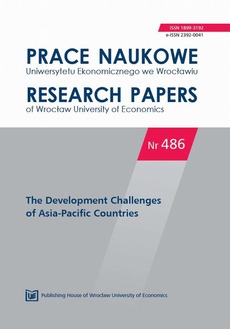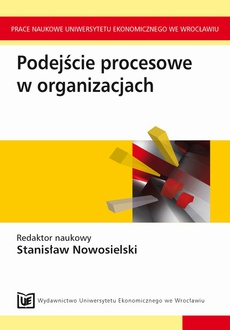POLECAMY

Prace Naukowe Uniwersytetu Ekonomicznego we Wrocławiu nr 486. The Development Challenges of Asia-Pacific Countries
Format:
ibuk
Globalization, growing competition and market complexity, as well as technology and enterprises innovation related changes that currently take place in the world create new challenges for Asia and Pacific countries, that have to set ambitious goals and take effective action in their development. The globalization processes affect the development of new forms of competition between countries, but they also become an important stimulator for the creation of various links and cooperation between the groups such as ASEAN and the EU as well as between the selected countries. These countries undertake initiatives to develop favorable economic connections and to ensure national security. There are clear structural changes happening, that show that the positions of former leaders are becoming less obvious. In this context, the question about China’s role in shaping the new economic order, determinants of this process and the problems it may cause is raised. Moreover, the great potential of emerging Asian markets requires the investigation of these markets and analysis of the development policies of selected countries and their role in shaping the competitive position and in the equalization of civilizational distances. These issues were addressed by the authors in the papers prepared for the 10th International Conference – Development challenges of Asia-Pacific countries, organized by the Department of International Economic Relations of Wrocław University of Economics in cooperation with the Center of Asia-Pacific Studies operating by the University. The articles in the first part of the volume refer to the economic expansion of the Asia-Pacific countries in the pursuit of the development objectives of selected countries with a special focus put on China, ASEAN countries, Japan and other, selected Asian countries. Among forms of expansion the authors have emphasized the importance of creation and development of China’s Special Economic Zones, the role of mergers and acquisitions conducted by Chinese companies on the European market, cluster-based development policies, and the use of foreign direct investment in the internationalization of Japanese enterprises. Moreover the role of emerging Asian economies in the global business services market has been shown. The focus was also placed on the goals, dilemmas and contexts of North Korea and Kazakhstan development. Last but not least the authors signaled the problem of changing the economic roles of Japan and China in East Asia region after the Asian crisis. The second part of the volume contains the articles devoted to the processes of cooperation between the countries of Asia, Europe and the world. At the outset, the “One Belt – One Road” initiative was introduced, emphasizing its role in supporting the EU’s European Neighborhood Policy. In the following articles, the authors analyzed various directions and aspects of cooperation between the selected ASEAN and the European Union countries, particularly focusing on the economic relations between countries such as Vietnam and Laos, in shaping of which the FDIs carried out in Laos by Vietnamese enterprises play an important role. The links between the Indonesian and Singapore capital markets, including the sudden stop phenomenon of regional and global financial crises period, were also analyzed. The third part of the volume presents selected trends and development strategies in selected regions of Asia. An assessment of the effects of the Chinese government’s intervention policy at the Shanghai Stock Exchange during the stock market crisis and the profitability of the carry trade strategy based on the Japanese currency were evaluated. Moreover, the subject of development policy issues of some countries, including South Korea, were raised, highlighting its role in the global economy. The trend of changes in consumption of agricultural and food products in China in comparison with other countries has been presented, with an attempt to assess China’s food self-sufficiency over the period considered. Finally the Asian perspective on the development of innovation and living standards in cities improvement, emphasizing the role of smart cities in implementing these purposes were presented.
Bogusława Drelich-Skulska, Anna H. Jankowiak, Karolina Łopacińska
| Rok wydania | 2017 |
|---|---|
| Liczba stron | 278 |
| Kategoria | Publikacje darmowe |
| Wydawca | Wydawnictwo Uniwersytetu Ekonomicznego we Wrocławiu |
| Numer wydania | 1 |
| Język publikacji | polski |
| Informacja o sprzedawcy | ePWN sp. z o.o. |
Ciekawe propozycje
Spis treści
| Introduction | 7 |
| Part 1 Forms of Asian Countries Economic Expansion in Implementation of the Development Policy Objectives | 9 |
| Jolanta Maroń, Kinga Szmigiel: Special economic Zones – opportunities and challenges for the development of China | 11 |
| Karolina Łopacińska: Chinese mergers and acquisitions on the European market in the chemical sector | 24 |
| Wojciech Hübner: The new role for China – how can we accept it? | 36 |
| Paweł Pasierbiak: In the quest for dominance in East Asia: Evolution of economic position of Japan and China | 49 |
| Artur Klimek: Advanced business services in emerging Asian economies | 61 |
| Anna H Jankowiak: Cluster-based development: A Chinese cluster policy | 71 |
| Andżelika Kuźnar: Międzynarodowy handel dobrami wysokiej techniki – przypadek Chin | 80 |
| Krzysztof Falkowski: The resources-dependent competitive profile of Kazakhstan and its consequences for the country’s future development | 92 |
| Sebastian Bobowski: Japanese micro, small and medium enterprises (MSMEs) in ASEAN | 103 |
| Chris Weston: The DPRK: Just another Country? | 114 |
| Part 2 Cooperation Processes between the Countries of Asia, Europe and the World | 127 |
| Katarzyna Żukrowska: China’s One Belt One Road Initiative as a support of EU’s European Neighborhood Policy | 129 |
| Grzegorz Mazur: EU-ASEAN free trade agreement(s) – prospects and challenges for inter-regional FTA | 141 |
| Wojciech Zysk, Marek Maciejewski: Umowa EUSFTA (UE – Singapur) szansą rozwoju polskiego eksportu | 155 |
| Andżelika Kuźnar, Jerzy Menkes: Asia’s pivot from the US towards…? | 167 |
| Elżbieta Majchrowska: EU-South Korea FTA as one of the new generation agreements – an overview of the effects of the agreement | 179 |
| Quang Phung Thanh, Nhat Linh Nguyen: Foreign direct investment from Vietnam to Laos in the context of integration | 194 |
| Magdalena Broszkiewicz: Sudden stops in portfolio investment flows to East Asia and Pacific Region An evidence from Indonesia and Singapore | 202 |
| Part 3 Trends and Strategies of Development in the Asian Region | 215 |
| Tomasz Bieliński, Magdalena Markiewicz, Magdalena Mosionek-Schweda: Do government interventions affect China’s stock market? Case study – analysis of the asset bubble in 2015–2016 | 217 |
| Iwona Pawlas: South Korea in the global economy in post-crisis period - an attempt of evaluation | 228 |
| Katarzyna Czech: The profitability of Japanese yen carry trades | 245 |
| Katarzyna Kita, Karolina Pawlak: Changes in the consumption of agrifood products and food self-sufficiency in China | 254 |
| Magdalena Rybicka: Czy Azja ma szanse zostać liderem w budowie inteligentnych miast? | 267 |
























